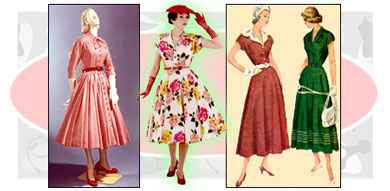Shirtwaist dress

Fashion Synopsis
Mother and daughter looks were all the rage in the 40’s and 50’s, and a good daughter’s role was to emulate her mother (and a good mother emulated Harriet or June). The crisp, clean style of the shirtwaist dress was a presentable choice for all ladies, whether mother or daughter, homemaker or Avon lady.
The shirtwaist dress was casual comfort and sophistication with the sleek style of a pleated skirt and a tiny, nipped-in waist. This prim and respectable style earned its name from the shirt styling of the top of the dress combined with the nipped-in waist. Ladies in the Victorian era would wear ‘shirtwaists,’ a shirt-style garment that looked as if it was indeed a whole dress when worn with a skirt, a belt forming the intersection of the two garments. This same Victorian hourglass figure was once again popular in the 50’s, and the shirtwaist dress maintained the title.
Shirtwaist dresses were one-piece garments, worn with a belt. The fitted, shirt-style top narrowed into a tiny waist, then expanded into a wide, gathered skirt. The attractive ‘wasp’ waist brought back the use of waist corsets for women, or the more comfortable and modern rubberized girdle. This extreme silhouette was an extension of the 40’s ‘New Look’ from Christian Dior, and bespoke elegance and poise. The 50’s skirts were fuller with pleated waists, supported with crinolines.
Young girls zipped into the dress in emulation of their graceful mothers, gliding across the living room floor in shirtwaist dress, pearls, short-heeled stilettos, apron and martini tray. The shirtwaist was a grown-up style for mature girls, while younger girls imitated the dress with the softer styles of lace collar and puff sleeves. Undergarments were necessary for the slim waist effect of the shirtwaist, and a girl’s first girdle was a rite of passage into womanhood. After all, the most popular mother in the world was never without her freshly pressed shirtwaist dress and pearls. Mrs. Cleaver, we salute you.
